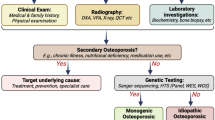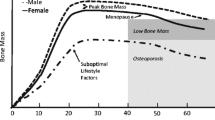Summary
Low bone quantity alone is insufficient cause for fragility fractures. This paper examines the role of bone quality in the fracture risk associated with age, sex, and race. Aspects of bone quality to be considered are bone architecture, matrix, mineralization, and fatigue damage. The trabecular network becomes progressively disconnected and weaker with age. Death of old osteocytes leads to hypermineralization and brittleness of bone. The stability of bone collagen declines with age, and unremodeled bone accumulates fatigue damage. The lower bone fragility rates in males than in females may be due to a combination of the larger male skeleton, greater cortical bone density after age 60 years, and greater bone turnover which would replace fatigue damaged bone. Fragility fracture rates in American and African blacks are lower than in whites, bone mineral density (BMD) is greater in American but not in African blacks (except for hip BMD), and American blacks have lower and African blacks higher bone turnover compared to whites. In South African blacks, trabeculae are thicker and better connected and trabecular bone undergoes less destructive age changes than in whites. To reconcile the disparate findings in American and African blacks we suggest that both groups have a genetic tendency to greater BMD than whites; American blacks realize this potential and African blacks do not, possibly because of calcium deficiency. Consequent high turnover removes fatigue damage and so improves bone quality. Weight-bearing activity in African blacks may be responsible for good hip bone density and thick trabeculae. American and African blacks have lower fragility fracture rates than whites for different reasons: American blacks because of higher BMD, and African blacks because of higher bone turnover, better hip BMD, and sturdier trabeculae.
Similar content being viewed by others
References
Wolff J (1892) Das Gesetz der Transformation der Knochen. Royal Academy, Berlin
Schnitzler CM, Pettifor JM, Mesquita JM, Bird MDT, Schnaid E, Smyth AE (1990) Histomorphometry of iliac crest bone in 346 normal black and white South African adults. Bone Miner 10:183–199
Birkenhdger-Frenkel DH, Courpron P, Hupscher EA, Clermonts E, Coutinho MF, Schmitz PIM, Meunier PJ (1988) Age-related changes in cancellous bone structure. A twodimensional study in the transiliac and iliac crest biopsy sites. Bone Miner 4:197–216
Jensen KS, Mosekilde Li, Mosekilde Le (1990) A model of vertebral trabecular bone architecture and its mechanical properties. Bone 11:417–423
Mellish RWE, Ferguson-Pell MW, Cochran GVB, Lindsay R, Dempster DW (1991) A new manual method for assessing twodimensional cancellous bone structure: comparison between iliac crest and lumbar vertebra. J Bone Miner Res 6:689–696
Wong SYP, Kariks J, Evans RA, Dunstan CR, Hills E (1985) The effect of age on bone composition and viability in the femoral head. J Bone Joint Surg 67A:274–283
Parfitt AM, Kleerekoper M, Villanueva AR (1987) Increased bone age: mechanisms and consequences. In: Christiansen C, Johansen JS, Riis BJ (eds) Osteoporosis 1987. Osteopress ApS, Copenhagen, pp 301–308
Urist MR, MacDonald NS, Moss MJ, Skoog WA (1963) Rarefying disease of the skeleton: observation dealing with aged and dead bone in patients with osteoporosis. In: Mechanisms of hard tissue destruction. Publication No 75 of the American Association for the Advancement of Science, Washington DC, pp 385–446
Dodds RA, Emery RJH, Klenerman L, Chayen J, Bitensky L (1990) Selective depression of metabolic activities in cortical osteoblasts at the site of femoral neck fractures. Bone 11:157–161
Frost HM (1960) Micropetrosis. J Bone Joint Surg 42A:144–150
Todd RC, Freeman MAR, Pirie CJ (1972) Isolated trabecular fatigue fractures in the femoral head. J Bone Joint Surg 54B:723–728
Vernon-Roberts B, Pirie CJ (1973) Healing trabecular microfractures in the bodies of lumbar vertebrae. An Rheum Dis 32:406–412
Oxlund H, Mosekilde Li, Ortoft G (1987) Alterations in the stability of collagen from human trabecular bone with respect to age. In: Christiansen C, Johansen JS, Riis BJ (eds) Osteoporosis 1987. Osteopress ApS, pp 313–316
Dodds RA, Ferris BD (1987) Changes in orientation of noncollagenous bone matrix in osteoporosis. In: Christiansen C, Johansen JS, Riis BJ (eds) Osteoporosis 1987. Osteopress ApS, Copenhagen, pp 309–312
Eventov I, Frisch B, Cohen Z, Hammel I (1991) Osteopenia, hematopoiesis, and bone remodeling in iliac crest and femoral biopsies: a prospective study of 102 cases of femoral neck fractures. Bone 12:1–6
Meunier P, Courpron P, Edouard C, Bernard J, Bringuier J, Vignon G (1973) Physiological senile involution and pathological rarefaction of bone. Clin Endocrinol Metab 2:239–255
Martin RB, Chow BD, Lucas PA (1990) Bone marrow fat content in relation to bone remodeling and serum chemistry in intact and ovariectomized dogs. Calcif Tissue Int 46:189–194
Mosekilde Li (1989) Sex differences in age-related loss of vertebral trabecular bone mass and structure—biomechanical consequences. Bone 10:425–432
Melsen F, Mosekilde L (1981) The role of bone biopsy in the diagnosis of metabolic bone disease. Orthop Clin North Am 12:571–602
Solomon L (1979) Bone density in ageing Caucasian and African populations. Lancet December 22/29:1326–1329
Itoh M, Dacso MM (1960) Rehabilitation of patients with hip fracture. Postgrad Med 28:138–145
Gyepes M, Mellins HZ, Katz I (1962) The low incidence of fracture of the hip in the Negro. J Am Med Assoc 181:1073–1074
Moldawer M, Zimmerman SJ, Collins LS (1965) Incidence of osteoporosis in elderly whites and elderly Negroes. J Am Med Assoc 194:859–862
Silverman SL, Madison RE (1988) Decreased incidence of hip fractures in Hispanics, Asians, and Blacks: California Hospital Discharge Data. Am J Publ Health 78:1482–1483
Cleveland M, Bosworth DM, Thompson FR (1947) Intertrochanteric fractures of the femur. J Bone Joint Surg 29:1049–1067
Lewis KM (1950) Internal fixation with Smith-Peterson nail and extension bar in treatment of intertrochanteric fractures of femur. Am J Surg 80:669–675
Dent CE, Engelbrecht HE, Godfrey RC (1968) Osteoporosis of lumbar vertebrae and calcification of abdominal aorta in women living in Durban. Br Med J 2:76–79
Adebajo AO, Cooper C, Evans JG (1991) Fractures of the hip and distal forearm in West Africa and the United Kingdom. Age Ageing 20:435–438
Lynch SR, Berelowitz I, Seftel HC, Miller GB, Krawitz P, Chariton RW, Bothwell TH (1967) Osteoporosis in Johannesburg Bantu males. Its relationship to siderosis and ascorbic acid deficiency. Am J Clin Nutr 1967:20:799–807
Bauer RL (1988) Ethnic differences in hip fracture: a reduced incidence in Mexican Americans. Am J Epidemiol 127:145–149
Smith EM, Cohen BE, Weinstein RS (1990) Racial differences in bone density (abstract). J Bone Miner Res 5 (suppl 2):444
Cohn SH, Abesamis C, Yasumura S, Aloia JF, Zanzi I, Ellis KJ (1977) Comparative skeletal mass and radial bone mineral content in black and white women. Metabolism 26:171–178
Dubowski J, Dubovsky EV, Balcarek K (1987) Differences in peak bone mass between black and white women are small (abstract 332). J Bone Miner Res 2 (suppl 1).
Liel Y, Edwards J, Shary J, Spicer KM, Gordon L, Bell NH (1988) Effects of body habitus and race on bone mineral density of the hip and spine in women. J Clin Endocrinol Metab 66:1247–1250
Vaswani AN, Aloia JF, Yeh JK (1991) Bone density in the lateral spine in black and white subjects (abstract 311). J. Bone Miner Res 6 (suppl 2)
Baker PT, Angel JL (1965) Old age changes in bone density: sex and race factors in the United States. Hum Biol 37:104–119
Trotter M, Broman GE, Peterson RR (1960) Densities of bones of white and Negro skeletons. J Bone Joint Surg 42A:50–58
Luckey MM, Meier DE, Mandeli J, Goldsmith S (1987) Axial and appendicular bone density in healthy white and black women (abstract 327). J Bone Miner Res 2 (suppl 1)
Bell NH, Shary J, Stevens J, Garza M, Gordon L, Edwards J (1991) Demonstration that bone mass is greater in black than in white children. J Bone Miner Res 6:719–723
McCormick DP, Ponder SW, Fawcett HD, Palmer JL (1991) Spinal bone mineral density in 335 normal and obese children and adolescents: evidence for ethnic and sex differences. J Bone Miner Res 6:507–513
Gilsanz V, Roe TF, Mora S, Boechat MI, Goodman WG (1991) Racial differences in vertebral bone density develop during puberty (abstract 215). J Bone Miner Res 6 (suppl 1).
Prentice A, Shaw J, Laskey MA, Cole TJ, Fraser DR (1991) Bone mineral content of British and rural Gambian women aged 18–80+ years. Bone Miner 12:201–214
Prentice A, Laskey MA, Shaw J, Cole TJ, Fraser DR (1990) Bone mineral content of Gambian and British children aged 0-36 months. Bone Miner 10:211–224
Patel DN, Pettifor JM, Becker PJ, Grieve C, Leschner K (1992) The effect of ethnic group on appendicular bone mass in children. J Bone Miner Res 7:263–272
Daniels ED, Pettifor JM, Patel DN, Schnitzler C (1992) Racial differences in bone mass-preliminary results (abstract 306). Bone Miner 17 (suppl 1).
Slemenda CW, Miller JZ, Hui SL, Reister TK, Johnston CC Jr (1991) Role of physical activity in the development of skeletal mass in children. J Bone Miner Res 6:1227–1233
Weinstein RS, Bell NH (1988) Diminished rates of bone formation in normal black adults. N Engl J Med 319:1698–1701
Bell NH, Greene A, Epstein S, Oexmann MJ, Shaw S, Shary J (1985) Evidence for alteration of the vitamin D-endocrine system in blacks. J Clin Invest 76:470–473
Meier DE, Luckey MM, Wallenstein S (1990) Biochemical evidence of racial differences in postmenopausal bone homeostasis in healthy white and black women (abstract 402). J Bone Miner Res 5 (suppl 2)
Peacock M, Johnston CC Jr, Hill CS (1992) Biomarkers of bone metabolism and bone loss in relation to estrogen status, race and osteoporosis (abstract 420). Bone Miner 17 (suppl 1)
Freeman MAR, Todd RC, Pirie CJ (1974) The role of fatigue in the pathogenesis of senile femoral neck fractures. J Bone Joint Surg 56B:698–702
Uhthoff HK (ed) (1986) Current concepts of bone fragility. University of Ottawa Press, Ottawa
Mellish RWE, Schnitzler CM, Dempster D (1990) Differences in two-dimensional trabecular bone structure between races. In: Christiansen C, Overgaard K (eds) Osteoporosis 1990. Osteopress ApS, Copenhagen, pp 149–151
Walker ARP (1972) The human requirement of calcium: should low intakes be supplemented? Am J Clin Nutr 25:518–530
Pettifor JM, Ross FP, Travers, R, Glorieux FH, deLuca HF (1981) Dietary calcium deficiency: a syndrome associated with bone deformities and elevated serum 1,25-dihydroxyvitamin D concentrations. Metab Bone Dis Rel Res 2:301–305
Author information
Authors and Affiliations
Rights and permissions
About this article
Cite this article
Schnitzler, C.M. Bone quality: A determinant for certain risk factors for bone fragility. Calcif Tissue Int 53 (Suppl 1), S27–S31 (1993). https://doi.org/10.1007/BF01673398
Received:
Accepted:
Issue Date:
DOI: https://doi.org/10.1007/BF01673398




